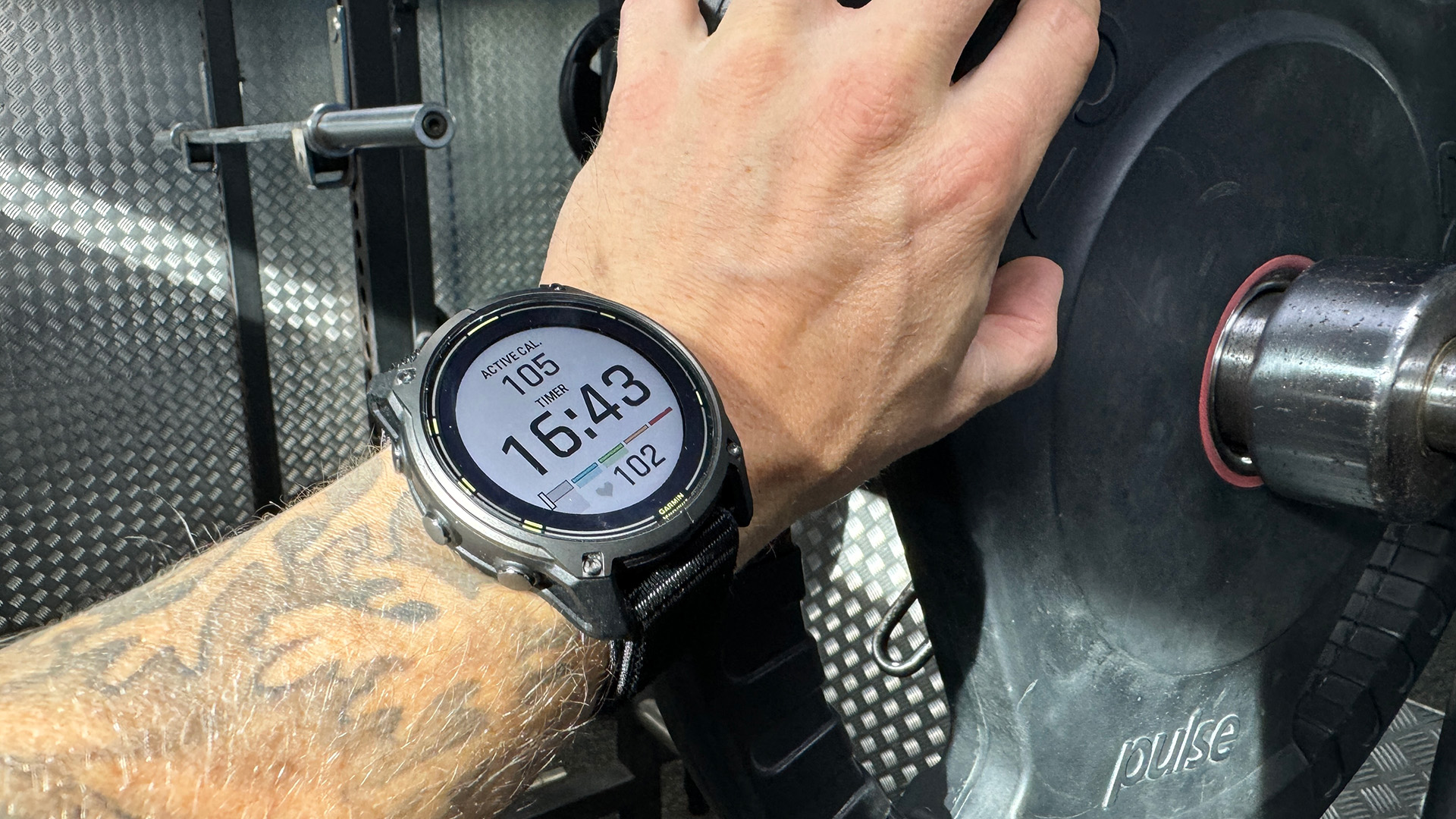Garmin Enduro 3 review: a battery life bruiser that lives for the adventure
Taking almost all of the best bits of the Fenix 8 and slapping it in a lighter, longer-lasting package makes the Enduro 3 one very enticing smartwatch for those wanting to go the distance


If you discount the fancy AMOLED screen and flashy titanium bezel of the Fenix 8, the Enduro 3 is arguably the better watch for ultra-athletes, endurance runners and general wilderness enthusiasts. The battery life is simply staggering, the watch itself lightweight and comfortable, while the user interface is on par with Garmin’s halo models. Despite this, the Enduro 3 is a large chunk of change cheaper than the Fenix 8 Solar and even costs less than the Enduro 2 it replaces. A no-brainer.
-
+
Battery life is monstrous
-
+
More accurate optical heart rate sensor
-
+
User interface is now easier to navigate
-
-
Overkill for casual runners and athletes
-
-
It’s huge on most wrists
-
-
Still a lot of money for a fitness watch
Why you can trust T3

Garmin is arguably the undisputed champion of the confusing and often muddled product line-up. Everything from its bike computers to automotive dash cams come with a seemingly endless choice of options, all of which borrow elements from one another, making the selection process fraught with research and indecision.
Granted, its line of fitness smartwatches has long sat at the very top of the tree when it comes to the best outdoor watches in general, but it doesn’t do itself many favours by constantly releasing new models that step on the toes of existing products.
The Garmin Enduro 3, which I have been testing here, is one such example, as it essentially borrows many elements from the Fenix 8 but pares it back in a lighter, simpler and longer lasting package.
As a result, you can chalk the Garmin Fenix 8 Solar up as its main rival, with only a lack of microphone, speaker and dive-ready waterproofing really separating the two.
However, the Enduro 3 costs much less, yet comes with a more impressive battery life. Can you see where we are coming from when we claim that Garmin likes to trip itself up?
More importantly, Enduro 3 has a handful of new features when compared to its predecessor, boasting an improved battery life thanks to a new solar array, a more user-friendly interface, a lighter overall package and that oh-so tempting price.
Garmin Enduro 3 review
Price and availability
At one point, the Garmin Enduro 3 was cheaper than the watch it replaces, but it appears the company has stamped all of that out, chiefly by axing the Garmin Enduro 2 from its main website.
Get all the latest news, reviews, deals and buying guides on gorgeous tech, home and active products from the T3 experts
The Enduro 3 costs £769.99/ $899.99/ AU$1,549 if you purchase it directly from Garmin UK, Garmin US and Garmin AU, although it is on sale via a number of online retailers, such as Blacks, Amazon and SportsShoes.com.
Seeing as it is so new, Garmin is yet to apply any kind of discount, but the knock-on effect has been that prices of Enduro 2 have fallen slightly already. We found the previous gen model on Sigma Sports for £699.99, but we expect prices to be slashed further still.
Specifications
- Dimensions: 51 x 51 x 15.7 mm
- Weight: 63g
- Display size: 1.4″ (35.56 mm) diameter
- Display resolution: 280 x 280 pixels
- Internal memory: 32gb
- Battery life (smartwatch): Up to 36 days/90 days with solar
- Battery life (GPS): Up to 120 hours/320 hours with solar, All Satellite Systems + Music: Up to 22 hours
- Sensors: 14 including GPS, accelerometer, gyroscope, heart rate, pulse ox and ambient light
- Connectivity: Bluetooth, Ant+ and WiFi
Design and build quality

As with many of the Garmin wearable reviews I undertake, it is rare that iterations of a particular model line vary a huge amount between generations. The same goes here: it is evolution, not revolution.
Overall, the package is around 7g lighter, which is a decent saving but very few will actually feel the tangible benefits when on the run. However, the weight saving means the tough titanium plate on the rear has gone, with a solid plastic piece replacing it.
There is no word on what this means for repairability, as the entire package looks like a sealed unit, which means it could be a nightmare. The overall effect is that it feels slightly less robust than its predecessor did - even if the 10ATM waterproof rating remains unchanged.
There is also a slight update to the shrouding around the main start button. It is still picked out in a cool contrast metallic green finish, but it now sits proud of the bezel, arguably making it slightly easier to locate.
Perhaps the biggest changes occur in the screen and solar array, which has had a major impact on maximum battery life, but also means that the sunlight-visible, transflective memory-in-pixel (MIP) is slightly sharper than before.
This is because the solar ring that surrounds the face has been made wider, negating the need for the touchscreen itself to also boast solar abilities. Hold the two watches up side-by-side and the Enduro 3 is definitely the punchier of the pair - although it still falls behind the super-sharp AMOLED found on the top-ranking and ridiculously expensive Fenix 8.
According to Garmin, most of the sensors and chipsets found under the skin are next-gen, so offer improved accuracy across the board. Arguably the most noticeable is Garmin’s Gen5 optical heart rate sensor, which is now cleared to take electrocardiogram (ECG) readings in certain countries and regions - painting a better overall picture of heart and cardio health.
That said, it’s still not brilliant for strength training or anything that requires grip, as this still seems to confuse optical heart rate sensors into thinking you’re not actually working. It’s the same story here.
Thankfully, the super-bright LED flashlight remains, which is actually a much handier feature than I ever imagined during testing. But, the Enduro 3 is still only available in one bezel size (51mm), colour and strap option.
It’s a large watch that dwarfed my skinny wrists.
Battery life

The battery life on the Enduro 3 is absolutely monstrous. Having been messing around with an Apple Watch Ultra 2 for a few weeks before receiving this watch to test, the differences couldn’t be more staggering.
Where a traditional smartwatch requires plugging in almost daily, the Enduro 3 will run for up to 90 days should you have access to enough sunlight to keep the batteries topped up.
And yes, before you get all irate about the lack of ‘real’ smartwatch features the Enduro 3 offers compared to Apple’s outdoorsy model (there aren’t many fancy third party apps worth installing on the Garmin), the run time delivered here is worthy of serious applause.
Even with all satellites and music running, the watch will have your back for up to 22 hours, but most serious endurance athletes will take advantage of Garmin’s Sat IQ feature, which automatically switches to the best satellite signal for the situation.
Dense forest or urban zones will naturally require a stronger, more battery-sapping signal, but this might not be the case once you hit wide open pastures.
A max battery GPS mode offers up to 210 hours of continual running, which is enough to cover even some of the longest ultramarathons on the planet.
Of course, these are maximal figures provided by Garmin and if you have the screen on constantly for map navigation, for example, these times will shorten.
But during testing, where I wore the watch day and night for a week or so, the battery life stayed fairly true to the readout estimates on the watch face.
I started with around 38 days of runtime after fully charging the unit and by day four, I still had 32 days remaining, despite using it in GPS-only mode to track a handful of trail runs and one interactive strength session in the gym, where I was constantly using the watch to track reps and weights.
Following a week of GPS-tracked outdoors walks with plenty of sunshine, the watch was still showing more than 25 days battery life remaining.
It was only during a longer forest hike, where I used the watch extensively to navigate on a route that I had pre-planned, did I see any real noticeable dent in the battery life. But due to tree cover, there wasn’t much light, so solar couldn’t do its thing.
Regardless, I tested the watch pretty heavily but it still didn’t require a charge. So long as you have access to sunlight, it will go on and on and on and on.
GPS performance and navigation

Admittedly, I’ve never been a huge fan of Garmin’s mapping system and those coming from smartphones and the best smartwatches will find it a bit clunky at first. Plus, interacting with a watch to first locate a point of interest, then selecting a route, panning and zooming while you do so is never easy, even with a slick touchscreen like this.
However, Garmin’s preloaded road, trail and ski resort maps are really designed for those who like to venture off the beaten path… for a really long time. Most of those slightly madcap folk will carefully plan a route in Garmin’s app or even have a list of coordinates or GPX files to hand.
This way, the watch is really only used sparingly to make sure runners, hikers, cyclists and other adventurous athletes are on the right track. And for that, it’s excellent, easy to read and now much faster to locate satellites, load maps and generally use.
Garmin is also one of the few to offer proper TopoActive mapping, so users can see terrain contours and elevation from the wrist. Pair this with the firm’s ClimbPro feature, and you get real-time information and feedback on climbs and descents on a downloaded course.
Also, Garmin has attempted to clean up the user interface, especially when an activity has been selected. There’s now the ability to swipe left or right to access further options, such as the music controller or mapping facilities.
In previous generations, a lot of this stuff was buried deep within sub menus and it could be a major distraction during a run or, at worst, downright infuriating.
It is a much cleaner approach and undoubtedly easier to navigate, but the Enduro 3 still takes a bit of getting used to, with the mix of touchscreen and button-pressing requiring some muscle memory before it becomes second nature.
Heart rate and activity tracking

Unless you are completely new to Garmin, you’ll likely know that its fitness watches track pretty much every activity imaginable. Football, mixed martial arts, Lacrosse, Ultimate Frisbee, Paddle tennis and even riding a quad bike all benefit from their own, individual activity profiles.
While there is much crossover between all of those (heart rate, calories burned and activity timer are all common traits), many of them feature much deeper metrics that even some professional athletes will find overkill.
Runners that like precision pacing will enjoy the grade-adjusted pace feature, which offers an equivalent running pace at the same effort on flat ground or when ascending. There are built-in rest timers for ultra-runs, analysis on heat and altitude acclimatisation, as well as reams of performance metrics to pore over after any activity.
Seeing as Garmin now tracks everything from resting heart rate to the quality of your sleep, the company can paint a detailed picture of training readiness, as well as a snapshot of overall health and any improvements (or decline) in fitness levels.
The Enduro 3 does all of this just as well as any other Garmin in this tier, featuring all of the sensors and activity tracking of the more expensive Fenix model. The only thing it really lacks when it comes to adventurous activity tracking is the ability to act as a dive computer, seeing as its waterproof rating can only handle swimming and surface-level watersports.
Smartwatch features

Those expecting Apple, Google or Samsung level of smartwatch with a Garmin product will be disappointed, and the Enduro 3 lacks the speaker and microphone hardware of the latest Fenix 8 model, so it’s even less of a lifestyle assistant.
If you are an iPhone user, all you will be able to do is reject calls and get notifications from any calendar entries, so long as they are synced with the Garmin Connect app. There’s also the ability to control music on your phone, but it’s clunky.
Android users get a little more, with the ability to text response or reject a phone call with a text, as well as view images from notifications, but it’s not exactly going to change your life.
Garmin has added a few widgets of late that attempt to tick the lifestyle box, such as real-time stocks information and a Morning Report that offers a weather forecast and upcoming calendar entries alongside insights into training readiness and your activity plan for the day.
But I have often found a lot of the lifestyle integration is a bit awkward on Garmin devices and there’s no change here. Spotify failed to download any of my playlists several times and would have a complete meltdown if someone interrupted my run (and pumping drum and bass playlist) with a poorly-timed phone call.
Also, the various watch faces all look a bit naff and are nowhere as fun or impressive as they are on an Apple or Samsung smartwatch, for example.
But hey, those watches can’t last 90 days on a single charge, nor are they very good at navigating the gruelling Montane Spine Race while offering an accurate grade-adjusted pace, detailed information on upcoming ascents and a reminder to put the bins out on monday.
Verdict

The previous generation Enduro 2 blew us away with its fantastic battery life, activity tracking and robust build quality, but it strangely cost more than the top-of-the-range Fenix 7X model at the time.
Thankfully, Garmin has got its pricing spot on this time around, and offers the Enduro 3 with a sizeable saving over the equivalent 51mm solar sapphire Fenix 8 model. Compare the two and, despite the obvious differences in build quality and design, there’s very little else to separate them.
If you already own the already excellent Enduro 2, there’s no real need to upgrade, as the battery life and next-gen sensor gains will be negligible.
However, if you are new to the ultra-marathon-friendly smartwatch game and need something that will support you through training and go the distance on race day, this really is in a class of its own.
Also consider
A few strong alternatives to the Garmin Enduro 3, which is designed for long-lasting battery life and multisport tracking, include:
Coros Vertix 2: This rugged adventure watch offers excellent battery life, advanced GPS capabilities, and multisport tracking features similar to the Enduro 3. It's well-suited for ultrarunners, hikers, and outdoor enthusiasts.
Suunto 9 Peak Pro: With great durability, solid multisport tracking features, and long battery life, the Suunto 9 Peak Pro is a sleek yet capable alternative. It's highly recommended for triathletes and trail runners.
Polar Grit X2 Pro: This multisport watch offers robust tracking for outdoor activities, especially focused on runners and cyclists. It includes extensive fitness features, solid build quality, and military-grade durability.
Leon has been writing about automotive and consumer tech for longer than he cares to divulge. When he’s not testing the latest fitness wearable and action camera, he’s out in a shed fawning over his motorcycles or trying not to kill himself on a mountain bike/surfboard/other extreme thing. He's also a man who knows his tools, and he's provided much of T3's drills coverage over the years, all without injuring himself.
